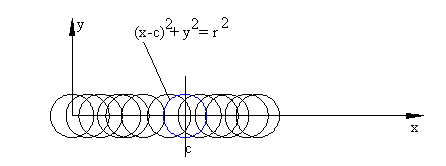8.5. CONSTRUCTION OF THE CAM PROFILE:
After the motion curve is defined and the cam size is determined, the actual cam profile can be found. One can either use geometrical or analytical method for cam profile determination. Since the accuracy of the cam profile is very important, mathematical methods are preferred.
Geometrical method for the cam profile determination for an in line roller follower radial cam was shown. In the following figure the cam profile determination for a radial cam with a flat faced follower is shown. In either case the procedure in generating the cam profile involves kinematic inversion; e.g. cam is fixed and the fixed link is rotated around the cam while the follower is displaced relative to the fixed link by an amount given by the motion curve. Before laying out the cam profile, the base circle radius and the motion curve for the whole cycle must be known. The relative positions of the links are same as that of the original motion. Through this process the cam profile is obtained as the envelope of all the cam profile positions.
Geometrical construction even when we use a CAD package will still require a lot of repetitive work. In some CAM packages there are special units within the package with which you can generate a cam profile.

Analytical method of cam profile determination makes use of envelope theory. A brief discussion of the envelope theory will be given here.
An Envelope can be defined as:
If each member of a family of curves is tangent to a certain curve and if each point of this curve at least one member of the family is tangent, the curve is either a part or the whole of the envelope of the family.
A family of curves with one parameter is in the form f(x,y,c)=0. c is the parameter. For each value of c we obtain a member of the family of curves. For example:
(x-c)2+y2=r2
Is the equation of a circle with radius r (constant) and center (c,0). Since c is the parameter for each value of c we have a different circle. Hence we have a family of circles.

We shall assume that the function f(x,y,c)=0 has as many continuous derivatives with respect to x, y and c as may be required. In addition we
shall assume that any singular point; e.g., points (x,y) satisfying ![]() on any curve having a particular value of c are isolated.
on any curve having a particular value of c are isolated.
The slope of any member in the family is:

Or this slope relation can be written as:
![]()
Which may also be written as:
![]()
This slope relation is valid for any member within the family. If another curve (the envelope) is tangent to a member of the family at a single point, its slope, likewise, must satisfy the above equation.
The total derivative of the function f(x,y,c)=0 is:
![]()
or
![]()
Since the sum of the first two terms is equal to zero from the slope relationship:
![]()
Hence the envelope must satisfy f(x, y, c) = 0 equation and ![]() . Then the envelope of the family of curves f(x,y,c)=0 is obtained by
. Then the envelope of the family of curves f(x,y,c)=0 is obtained by
eliminating c from f(x,y,c)=0 and the partial derivative of the function with respect to the parameter c: ![]()
If the family of curves is given in parametric form as:
![]()
Where s is the curve parameter (by changing s we obtain x,y values of a member in the family with a value c. For example the family of circles ican be written in parametric form as x=c+rcos(s), y=rsin(s)) The envelope is obtained by the elimination of c from these eqations and
![]()
Example 8.4.
Determine the envelope of the family of circles given by the equation:
f(x,y,c)= (x-c)2+y2-1=0
Using the above equation and its partial derivative with respect to c:
fc=-2(x-c)=0
We can eliminate c from f = 0 and fc =0 to obtain the equation of the envelope:
y=±1
Thus the horizontal lines y=1 and y=-1 are the envelopes of the family of circles as shown.

Example 8.5
Determine the envelope generated by the falling of a ladder from a vertical wall while the ends of the ladder are in contact with the wall and the floor as shown.

The parametric equation of the ladder is:
y= -x tang +l sing
where g is the angle between the horizontal and the ladder and l is the length of the ladder. Writing the above equation in the form:
f(x,y,g)= y+ x tan g –l sin g = 0
Partial derivative of the function with respect to g is:
![]()
Solving for x and y from these equations:
x = l cos3 g
y = l sin3 g
Eliminating the parameter g (note that the last two equations are the equations for the envelope in parametric form and it can be used to draw the envelope. For each value of g we obtain a point on the envelope):
![]()
Which is the equation of asteroid.
Example 8.6.
Using a gun we shoot a bullet with an initial velocity v at an arbitrary angle a . (Initial velocity v is determined by the type of the bullet, a gunmen cannot control v, he can only control the inclination angle a) We want to determine the area (volume) within which we can shoot an object. We neglect air resistance.

This is the classical projectile motion that is thought in high school physics. The bullet will travel at a constant velocity in x (horizontal) direction and it will be subject to a constant gravitational acceleration in y (vertical) direction. Hence the position of the bullet at any time t is given by:
x = v cosa t
y = v sin a t – ½ gt2
We can eliminate the parameter t from the two equations to obtain the trajectory:
f(x, y, a)= 
This gives us a family of curves with a as the parameter. Each member of the family is a parabola. When we take the derivative of the function with respect to the parameter a:
fa(x, y, a)= ![]()
when simplified:
x cos 2a + y sin 2a = 0
If we eliminate a from the equations f(x,y,a) ve fa(x,y,a) we obtain the equation of the envelope as:

The envelope is another parabola. The result is shown below. Note that the bullet can reach any point under the parabola.
A-) Cam profile for a radial cam with translating roller follower.
B-) Cam profile for a radial cam with flat faced oscillating follower.